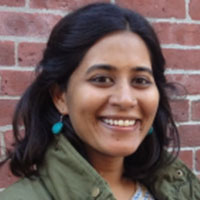Contributor : Profile
S Anukriti is a Senior Economist at the World Bank's Development Research Group. Her research examines the underlying causes of gender inequalities in developing societies, and explores mechanisms that can bring about gender equity. She is an applied micro-economist with interests in the fields of development economics, economics of gender and the family, and political economy. She received her PhD in Economics from Columbia University, an MA in Economics from the Delhi School of Economics, and a BA (Honors) in Economics from St. Stephen’s College, Delhi. She is also a Research Fellow at the Institute for Labor Economics (IZA). Prior to joining the World Bank, she was an Associate Professor of Economics at Boston College.
Posts by S Anukriti
Bring a friend: Leveraging financial and peer support to improve women’s reproductive agency
In the second of two articles about women’s fertility and family planning, S Anukriti et al. highlight findings which reveal that women are more likely to avail of family planning services if they a...
-
 S Anukriti
S Anukriti  Catalina Herrera-Almanza
Catalina Herrera-Almanza  Mahesh Karra
Mahesh Karra  21 August, 2023
21 August, 2023
- Articles
Convincing the Mummy-ji: Improving mother-in-law approval of family planning in India
In the first of two articles about women’s fertility and family planning, Anukriti et al. discuss the influence that mothers-in-law have on women’s access to family planning services, with them on...
-
 S Anukriti
S Anukriti  Catalina Herrera-Almanza
Catalina Herrera-Almanza  Mahesh Karra
Mahesh Karra  Rocío Valdebenito
Rocío Valdebenito  18 August, 2023
18 August, 2023
- Articles
दहेज ग्रामीण भारत में परिवार के फैसलों को कैसे प्रभावित करता है?
यह व्यापक रूप से माना जाता है कि भारतीय माता-पिता बेटी के पैदा होते ही दहेज के लिए बचत करना शुरू कर देते हैं। ग्रामीण भारत में दहेज पर दो-भाग की श्रृंखला के इस दूसरे भाग में, यह लेख इस बात की जांच करत...
-
 S Anukriti
S Anukriti  Sungoh Kwon
Sungoh Kwon  Nishith Prakash
Nishith Prakash  22 जुलाई, 2021
22 जुलाई, 2021
- लेख
ग्रामीण भारत में दहेज प्रथा का क्रमिक उद्भव: 1960-2008 के साक्ष्य
1961 से अवैध घोषित किये जाने के बावजूद, दहेज परंपरा ग्रामीण भारत में व्यापक रूप से फैली हुई है। दो - भागों की श्रृंखला के इस पहले भाग में, यह लेख राज्यों और धार्मिक एवं सामाजिक समूहों में 1960 - 2008 ...
-
 S Anukriti
S Anukriti  Sungoh Kwon
Sungoh Kwon  Nishith Prakash
Nishith Prakash  15 जुलाई, 2021
15 जुलाई, 2021
- लेख
दो बच्चों की सीमा का स्थानीय राजनेताओं पर प्रभाव
भारत के कुछ राज्यों में दो से अधिक बच्चों वाले व्यक्तियों को स्थानीय चुनाव लड़ने की इजाजत नहीं है। इस कॉलम से पता चलता है कि इस प्रकार के कानून के कारण ऐसे राज्यों में सामान्य जनता के बीच प्रजनन दर क...
-
 S Anukriti
S Anukriti  Abhishek Chakravarty
Abhishek Chakravarty  12 जुलाई, 2021
12 जुलाई, 2021
- लेख
Evolution of dowry in rural India: Evidence from 1960-2008
Despite being illegal since 1961, dowry continues to be a widespread phenomenon in rural India. In the first of a two-part series, this article tracks the evolution of dowry during 1960-2008 across st...
-
 S Anukriti
S Anukriti  Sungoh Kwon
Sungoh Kwon  Nishith Prakash
Nishith Prakash  01 July, 2021
01 July, 2021
- Articles
How dowry influences household decisions in rural India
It is widely believed that Indian parents start saving for dowry as soon as a daughter is born. In the second of a two-part series on dowry in rural India, this article examines how dowry influences h...
-
 S Anukriti
S Anukriti  Sungoh Kwon
Sungoh Kwon  Nishith Prakash
Nishith Prakash  01 July, 2021
01 July, 2021
- Articles
सास अपनी बहुओं के सामाजिक नेटवर्क तथा प्रजनन स्वास्थ्य को कैसे प्रभावित करती हैं?
परिवार के सदस्यों द्वारा लगाए गए प्रतिबंधात्मक सामाजिक मानदंड एवं रणनीतिक बाधाएं, महिलाओं की सामाजिक नेटवर्क तक पहुंच और उससे प्राप्त होने वाले लाभ को सीमित कर सकती हैं। ग्रामीण उत्तर प्रदेश में एक स...
-
 S Anukriti
S Anukriti  Catalina Herrera-Almanza
Catalina Herrera-Almanza  Mahesh Karra
Mahesh Karra  08 सितंबर, 2020
08 सितंबर, 2020
- लेख
How mothers-in-law influence women’s social networks and reproductive health
Restrictive social norms and strategic constraints imposed by family members can limit women’s access to and benefit from social networks. Based on a survey in rural Uttar Pradesh, this article show...
-
 S Anukriti
S Anukriti  Catalina Herrera-Almanza
Catalina Herrera-Almanza  Mahesh Karra
Mahesh Karra  03 August, 2020
03 August, 2020
- Articles
Financial incentives and the fertility-sex ratio trade-off in India
Fertility reduction and a gender-balanced population often appear to be conflicting objectives in countries with persistent son preference and easy access to sex-selection technology, as targeting one...
-
 S Anukriti
S Anukriti  25 June, 2018
25 June, 2018
- Articles
How female foeticide has influenced fertility and parental investments in girls
The introduction of ultrasound technology in India has been documented to have led to a phenomenal increase in abortion of female fetuses. However, this column finds that it also decreased son-biased ...
-
 S Anukriti
S Anukriti  Sonia Bhalotra
Sonia Bhalotra  Hiu Fung
Hiu Fung  11 September, 2017
11 September, 2017
- Articles
Impact of the two-child limit for local politicians
Some Indian states debar individuals with more than two children from contesting local elections. This column finds that while the law has significantly reduced fertility among the general population...
-
 S Anukriti
S Anukriti  Abhishek Chakravarty
Abhishek Chakravarty  02 March, 2015
02 March, 2015
- Articles




